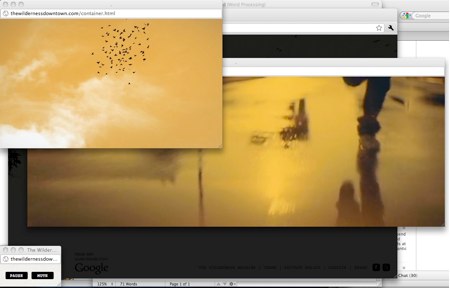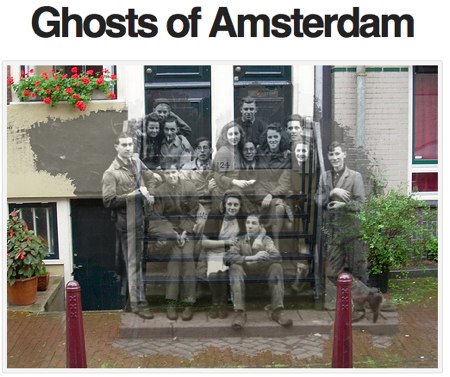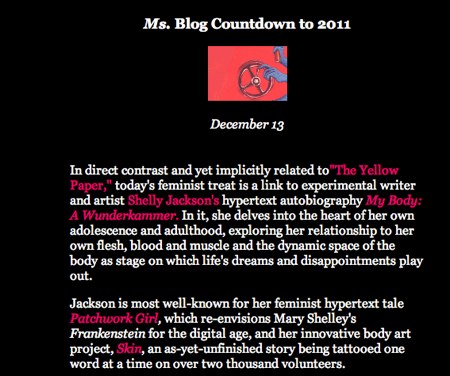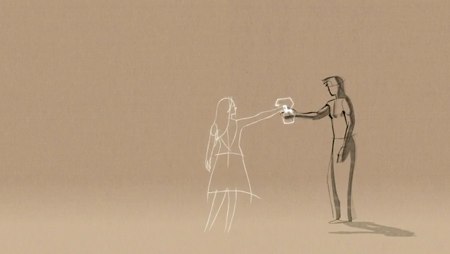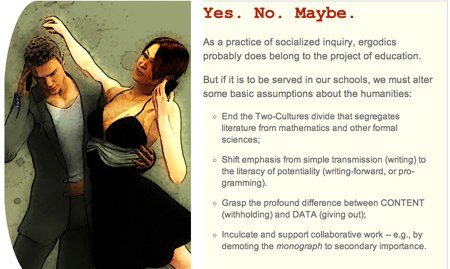The Wilderness Downtown is an interesting short film that takes a street address and uses Google’s street view to add scenery from that address into the film. It’s a fun little video with catchy music. It’s not kidding when it says it runs best in Chrome or that it’s incredibly computationally intensive, so make sure to close everything else you’re doing when you watch it.
Isle of Tune is a clever Flash-based music sequencer uses cars to represent voices, and roadside scenery to represent sounds. An intriguing musical toy, this is also an interesting example of a playful interface that could generate intriguing new ideas.
The Association for Computers and the Humanities asks “What’s the difference between Digital Humanities and New Media?” It’s an interesting question, but one that perhaps cannot be answered. Not only do academics and professionals use the same terminology to mean wildly different things, but even the academic disciplines can’t seem to agree on what constitutes “new media” or, for that matter, “literature.”
We may be witnessing the process of disciplinary formation, but perhaps we’ve merely stumbled upon a turf war. An interesting discussion is unfolding in the comments, and the limitations of our nomenclature is a problem we should not ignore.
The fascinating anachronism-lover’s blog, How to be a Retronaut, recently featured Ghosts of Amsterdam, an incredible work by Jo Teeuwisse which combines old photographs with photographs of the same locations today. Uncanny, ghostly images of present-day places blend with haunting people and mementos .
How to be a Retronaut taps an interesting genre that did not exist before Photoshop and mashup/remix culture. See also their Victorian Star Trek and the remarkable Augmented Reality Panorama.
ACM SIGWEB has issued a call for abstracts for the Web Science Conference 2011 . Web science tends to take a broad view of Web concerns, focusing on both its technical and sociological aspects.
Possible submission topics include:
- On-line lives: individuals and organizations shopping, dating, learning, networking
- Trust and privacy
- Evolving technologies – new search technologies, linked data, new Web languages and/or protocols, and emerging application areas
- The pro-human web in an unequal world: access, inequalities and agendas for change
- Web futures: possibilities critiques and challenges
- The web and the state: nationalism, politics. democracy
- Governance control and power
- Knowledge, education, and scholarship – the potential and effects of crowdsourcing and long tails
- Intellectual property and the Commons
- The dark side of the Web – such as cybercrime, pornography and terrorism
The submission deadline for abstracts is Feb 28, 2011. The conference will held be in Koblenz, Germany from June 15-17, conveniently following ACM Hypertext 2011 in Eindhoven will take place June 6-9 . Submission deadline for full and short papers for Hypertext 2011 is January 29.
Hyper Island’s digital media school —with no teachers, no essays, and no grades—will be opening in Manchester to offer students a novel approach to new media pedagogy.
"We actively encourage failure in our students" says Hyper Island director David McCall.
Failure is indeed an important part of learning, though most institutional practices tend to ignore this fact. However, rather than the standard institutional course structure, the Hyper Island curriculum focuses largely on leadership training and team-building exercises before plunging students directly into building digital projects. In fact, the methodology that underlies the school’s pedagogical practices originated with the US military to train soldiers in leadership and decision-making in a fast-moving and changing environment.
The blog for Ms. Magazine features an Advent Calendar with a daily feminist treat. The treat for December 13, selected by Aviva Dove-Viebahn, was Shelley Jackson, author of Patchwork Girl.
Animator Ryan Woodward drew a beautiful short film, Thought of You. It’s accompanied by a fascinating video on the making of the animation, as well as numerous sketches and drawings. Superbly done, a new media landmark.
(Thanks, Scott McCloud!)
;
David Goldman asks why we can’t hear Wagner’s music. First, modern performance either subvert opera or bathes the work in special effects. But, more deeply, movie music of the 20th century makes the effects of the late 19th seem familiar and safe. An interesting, detailed, and accessible musicological argument grounds his exploration of what Wagner set out to do, and why.
In a recent talk, Stuart Moulthrop (University of Wisconsin/Milwaukee) explores new media and hypertextuality in light of the global financial disaster.
This might appear to be just another expression of vaguely Marxist sentimentality so common in criticism that’s intended to impress without meaning much, but (as usual) Moulthrop’s doing real work here.
The central argument calls for a shift from simple transmission(writing) toward a literacy of potentiality (programming), and for grasping the difference between content (which Moulthrop assumes to require witholding) and data (which becomes itself by being given out to your colleagues). Perhaps for content we might instead read “melodrama” – the canned narratives of Hollywood that keep us amused, contrasted to the things we create ourselves.
Broadcastr appears to be a stealth-launch Web service for syndicating audio: Twitter meets radio. (Apparently there’s a geographic angle, too, though I don’t quite understand why I care where my story is located, as long as I know the language.)
What’s really interesting, though, is their audio prequel. It’s very nicely made and edited. Behind what appears to be nearly found sound – regular folks beginning to tell stories – are allusions to standup and storytelling, hints of sex and politics and religion, lots of youth and just a touch of music. Very slick.
Laurent Saurerwein, a new media artist who has recently moved from Paris to Berlin, calls our attention to Forgotten Books publisher of books in the public domain. Books are available as pdf and in paperback. It’s an interesting idea.
The execution appears to leave something to be desired. The very first title in the fiction catalog’s “Classical” section, for example, is John Oxenham’s 1914. Here’s the excerpt:
"1914" I T HE ~1.rly morning of July 25th, I9I 4, was not at all such 'as the date might reasonably have led onc to expect. It was gray and overcast, with heavy dev lying white on the grass and a quite unseasonable rawness in the air. The clock on the mantelpiece of the morning-room in The Red Housej ,Vi11stead, was striking six, in the sonorous Westqnnster chimes, which were so startlingly inconsistent with its size, as Mr John Dare drew the bolts of the French ,vindowand stepped out on to his back lawn.
Now, this seems indeed an obscure book, one that isn’t listed at all in (presumptive) author’s wikipedia bibliography. Assuming it is indeed the work of William Arthur Dunkerley, who wrote as John Oxenham, its a minor novel of best-selling writer, just the sort of forgotten book that might be worth a fresh look. (Compare, for example, John Buchan’s wonderful Greenmantle, published the same year).
But the excerpt has clearly not been examined by anyone. It reads as a parody of bad OCR. “Westqnnster chimes?” It’s the first item in a long list; you’d think someone would notice. Some of the other titles seem to be better, but not all: here’s the opening of Can You Forgive Her?
"WHETBER or no, she, whom you arc to forgive, if you can, did or did not belong to the Upper Ten Thousand of this our English world, I am not prepared to say with any strength of affirmation."
And, if you’re going to place a forgotten title in a list beside Dickens and Verne and Trollope, might you spare the reader a word about why it belongs?
Neal Hoskins discusses “Stories in Layers” – fiction (or, in this case, illustrations) with easter eggs that are revealed after a specified date or when designated events occur.
Earlier in October 2010 we released our latest story – Scruffy Kitty – with a special time-locked layer of artwork that became visible just in time for halloween, so to all our readers who opened the app on October 30th – surprise, surprise! – a pumpkin and many other fun halloween objects magically appeared for the first time.
.
